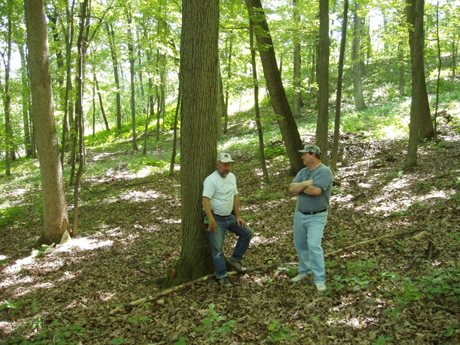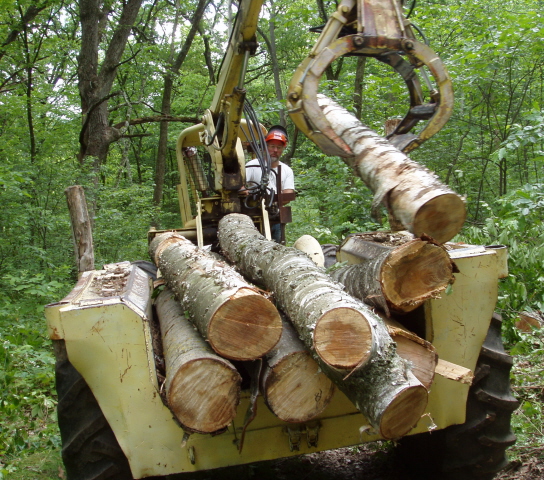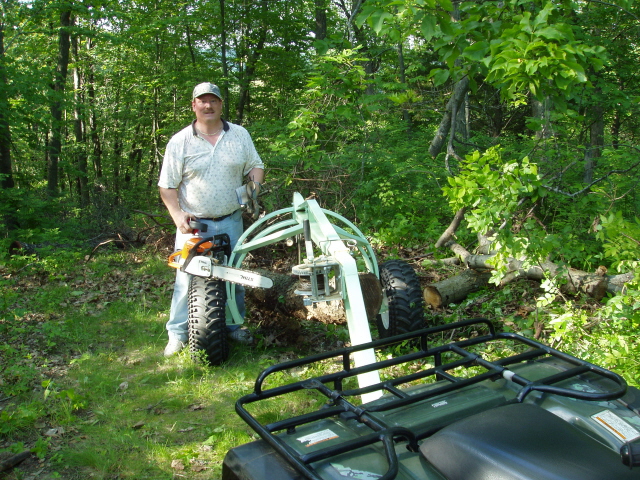

Our forest is a very beautiful place. We have 200 acres of timber growing on our hillsides and ridegtops. The forest changes every step you take and each time you take a walk. We have learned to make the most of each opportunity as we work to restore the land that has been high-graded, grazed, and farmed - to the most natural condition possible.
Our forest is very productive. Our annual growth of saw timber averages 400 board feet per acre, plus another 100 board feet in small diameter logs. If we harvested our annual growth this year, it would fill 25 log trucks, or produce over two acres of finished flooring. This is more wood than we need to run our flooring business, so our inventory of standing trees is accumulating at this time. We are timber rich! Nice!!
Our forest supplies our family business. We are able to take as much wood as we need each year to earn the amount of money we desire. Potentially, I could hire six full time workers to fully utilize the growth of our woods, but I don't choose to work that hard right now. SCUBA diving, teaching, and enjoying life keep me busy about half the time these day. Shawn and I make a good living working just part time in the flooring business. The growth from 50 acres would actually supply us.
Trees are living solar collectors. Light from the sun is the primary need for growth. The surface area of the tree's leaves that are exposed to direct sunlight determines how fast a tree can grow. Most hardwood trees attain optimum growth when the width of their crown is about one third of the trees total height. For conifers, the crown width to tree height ratio is one fourth. This should produce an annual growth ring of 1/8" to 1/4". The size of the tree's leaf canopy is determined by the spacing between trees.
In dry climates, water may be the crucial growth need. The sames principles work here too. Tree spacing affects how much water is available to each tree.
This year I will salvage oak and elm trees that have died of oak wilt and dutch elm disease, and a few trees that are suppressed and defective nearby. I fell the trees using directional felling methods taught in the Game of Logging. This method is pretty safe, protects the butt log from splitting, and controls the fall of the tree to minimize any damage to my other timber. I skid the logs to a trail with the radio controlled winch on the farm tractor. When possible, the fetching arch is used to lift the log off the ground as I pull. The logs are accumulated by the trail, then picked up by the prehauler and carried down to the sawmill.

Dead Paper Birch and Aspen are salvaged - Birch is a flooring favorite!
I love to go logging - it is exciting and rewarding. I'm never in a hurry and only work when the weather is good and the ground is firm. It is best to cut timber when the trees are dormant, the bark is hard, and insects & disease is minimal. Whenever I carry a chain saw, there is always Timber Stand Improvement work to do also. Cutting the grape vines off my good trees is a top priority for me. Pruning dead branch stubs off of crop trees is very important too. Thinning, weeding, and encouraging diversity are always in progress. Forestry is a continuous process - always tend your forest.
We have developed high value uses for every tree species, so every tree has value here. A knotty tree is just as valuable as a clear "Veneer" log, though I do love to saw those nice big, straight, knot-free logs! Since our forests are mainly oak, I treasure every baby sugar maple, ash, walnut, red elm, pine, or cherry. Diversity is important with all the diseases that threaten a single species.
When harvesting, I always take the worst tree first. Allow the good trees to grow as long as they are vigorous and healthy. Since we can harvest any tree, any year, we rarely waste a good tree that dies. The only time I get to cut and sawmill our good trees is just after they died of oak wilt or dutch elm disease. Yep, a dead tree is mature - not going to get any bigger!
In a healthy stand, we can take one large tree per acre each year. Often we instead take several smaller trees that total the same amount of wood. This keeps the forest canopy fully intact to maximize the annual growth.
To do annual timber harvests and tend the forest, a good system of roads and trails is needed. We have over 8 miles of woods roads and trails on our 300 acre farm. I can get within 165 feet of any tree with my winch cable with the tractor never leaving the road. We don't drive any machinery around through our forest, now that regeneration is getting established. The tractor and prehualer stay right on the trail. An ATV skidding arch seems pretty low impact and is useful for a single tree here and there.

The best part is installing the harvested wood in a customer's home and receiving full retail prices for our products. We eliminate every forester, timber buyer, logger, broker, middleman, shipper, wholesaler, and retailer and keep all the money to ourselves. Direct sales of finished products means there is good income from every step of the process.
Full Vigor Forestry is not possible in the commecial timber markets. The prices paid for logs delivered to the mills are too low for anyone to spend the time and do things right.
A landowner can take care of their own woods better than any visiting "professional". Take time to learn to earn a good profit from your woods.